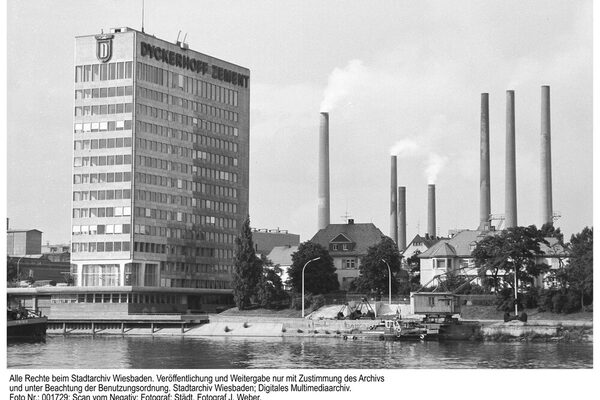Amoeneburg (Mainz-Amoeneburg)
The smallest AKK suburb with around 1,400 inhabitants is located along the Rhine between the districts of Biebrich and Mainz-Kastel. The border between the territory of the Electorate of Mainz and Nassau was already drawn here in the Middle Ages. At the beginning of the 19th century, the Landgraben separated the Duchy of Nassau from the Grand Duchy of Hesse (Darmstadt) and later Prussia and (since 1918) the People's State of Hesse.
Amöneburg is a relatively young district. Although the Romans had already settled here, as indicated by a votive stone from 224 AD, it was not until the beginnings of industrialization in the mid-19th century that systematic development began. The first residential building was erected in 1858.
The economic upturn was brought about by the establishment of factories. It began in 1852 with the Rheinische Glasfabrik. In 1861, the brothers Eugen and Heinrich Albert moved their factory for the production of artificial fertilizer here. In 1864, Wilhelm Gustav Dyckerhoff founded a cement works, and in 1875 Georg Lembach built a lime kiln and tuff factory. With the establishment of the factories, the number of inhabitants grew (1860: 107, 1900: 1,631, 1940: 1,800, 1950: 2,300). Politically, Amöneburg belonged to Kastel and was incorporated into Mainz on 01.04.1908. However, Amöneburg was still a suburb of Biebrich in economic terms, especially in terms of postal and railroad services. A barracks for pioneer troops was built right next to the Kaiserbrücke bridge in 1906-08, which today serves as accommodation for the Hessian riot police.
Heavy air raids during the Second World War caused great destruction on several occasions - especially on 19.09.1944, when over 250 heavy bombs fell on the Biebrich-Amöneburg industrial area. However, this was followed by reconstruction and the years of the economic miracle. The community continued to expand with new buildings. The Dyckerhoff & Söhne AG administration building, erected in 1961, was a visible sign of the upswing. Modern office and residential buildings, a daycare center and sports facilities at the Kaiserbrücke bridge dominate the townscape alongside the Protestant Gustav Adolf Church and the Catholic Maria Immaculata Church.
The name "Amöneburg" first appears officially in 1844 on the occasion of the new survey of the Kastel municipality. The place names "Heimersburg" (1487), "Hyemelsburg" (1532) and "Heymannsburg" (1546), "Hammelsburg", "Ammelsburg" and "Ammelburg" are mentioned in earlier documents. The coat of arms of Amöneburg shows two crossed golden (yellow) keys in blue above a silver (white) cross stream, which refer to the location on the Rhine and the affiliation to St. Peter's Abbey in Mainz.
Opposite Amöneburg, the Petersaue, one of the largest inland islands in the Rhine, stretches over a length of 2.98 km. It too was once owned by the Mainz monastery. The city of Mainz obtains most of its drinking water from the Rhine via the waterworks on the island. InfraServ Wiesbaden operates a wastewater treatment plant for the Kalle-Albert industrial park on the downstream part of the Petersaue.
Literature
Brilmayer, Carl Johann: Rheinhessen in Vergangenheit und Gegenwart, Gießen 1905 [p. 34].
Kraus, Georg: Aus der Geschichte Amöneburgs, Biebrich 1914.
